#Vito Russo Test Fail
Text
I genuinely don't think straight people can even begin to grasp how upsetting the homophobia in the ted lasso fandom is starting to become. It's coming from all sides: casual viewers i speak to in real life who laugh in my face when i mention the possibility of any of the main characters being queer ("there's more than enough gay stuff with colin being there", "you're making the keeley stuff up she's obviously straight cause she's with roy"), people on the internet saying "who even is this colin guy?" after him being on the show for 3 seasons or "baz doesn't need to be gay as well, stop making everybody gay". And this is about the show that's all about be true to yourself! Be curious not judgemental! Be kind! This show managed to curate that kind of audience. It all just feels so fucking impossible sometimes.
#i honestly think ted lasso is gonna fail the vito russo test#cause the potential queer characters they seem to have set up for a queer storyline (excluding keeley cause she'll end up with roy/jamie)#are all minor side characters#and people will be able to skip their isolated 2 minute scenes and just watch the rest of the show uninterrupted#and if the shwo does pass the test then the situation in the fandom is gonna get really fucking nasty#which is fine cause queer people are used to that#i know i say this with ⅔ of the season still ahead of us but then again that means i've seen 7/9 of the whole show#and i don't seem the earnestly turning this thing around in a meaningful way#and as i said even if they do against all odds then the fandom will turn into fight club#meaning queer fans are gonna be the target of hate either way#ted lasso spoilers#just realised how many typos there are in the tags so please ignore that i was Ranting <3
50 notes
·
View notes
Text
Review: Year One
By: Nora Roberts
Available on: Amazon, Audible, and Barnes and Noble.Overview:
Blurb: It began, much as it did for us, with a sickness that spread quick and deadly. But rather than COVID-19, the Doom, as it is known, killed millions and awakened the magical bloodlines in some of the survivors. Now, the world is an apocalyptic hellscape with the best and worst of humanity on open display. Magic…
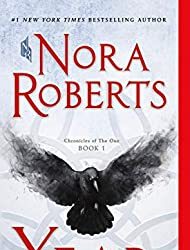
View On WordPress
#4.0 out of 5#Bechdel-Wallace Pass#Bipolar Disorder#Death#Deggan Rule Test Pass#DuVernay Test Pass#Ellen Willis Test Pass#Magic#Mako Mori Test Pass#Mary Sue Test Pass#Paranormal Romance#Post-Apocalyptic Science Fiction#Reading#Reading as a Coping Mechanism#Reading Challenge#Review#Romance#Sexy Lamp Test Pass#Tauriel Test Pass#Vito Russo Test Fail
0 notes
Text
This might be controversial but it feels icky that the third explicitly queer character and the first explicitly trans character in wings of fire is:
-Misgendered by a supporting character (like I guess casual lgbtq+ representation is only for the cis)
-Only personality is that they're nonbinary, like books and are big brained
-Does not talk to the main character but also only exists to further the goals of the main characters
-Failed the vito russo test
#like I guess Tui was trying but try harder#and they did so well with Sundew and Willow#wof book 15#it feels like Tui was told they should put nonbinary people in the books but had no idea how to be normal about it#so decided to establish the genderqueerness of the character in the most awkard way possible#queer#wof spoilers#transphobia#tui failed miserably at casual trans rep lol#/srs /neg
3 notes
·
View notes
Text
Yikes. Been seeing some misinformation about the Vito Russo test pass around, so lemme drop a few points. The test is... basic. Very basic. But these are the explicit points. The following must be true. Collectively. There’s no “or.”:
The film contains a character that is identifiably lesbian, gay, bisexual, and/or transgender.
That character must not be solely or predominantly defined by their sexual orientation or gender identity. I.E. they are made up of the same sort of unique character traits commonly used to differentiate straight characters from one another.
The LGBTQ character must be tied into the plot in such a way that their removal would have a significant effect. Meaning they are not there to simply provide colorful commentary, paint urban authenticity, or (perhaps most commonly) set up a punchline. The character should “matter.”
All three are required to pass the vito russo test. (Source: GLAAD)
Please be mindful to not accidentally cause harm to the VRT by not checking it out.
As per the 2014 article,
Less than half (7) of the 17 major studio films GLAAD counted LGBTQ characters in managed to pass the Vito Russo Test this year, compared to 6 out of 14 inclusive films released in 2012. Clearly there is a lot of room for improvement in Hollywood film. With this annual report, GLAAD will continue to track the industry’s progress.
That is to say, even inclusive films suck at passing this test most of the time. They tend to get, say, point 3, but in trying to shove forward quick slapped together representation miss 2. Or so on. Whereas big cinema tends to, say, miss part 3, and also fail.
For example, Castiel actually passes this test -- he’s identifiably genderqueer (his gender is not tied to sex and he has even changed his sex, and as a genderless/sexless species it’s quite literally impossible to be cis even while properly claiming a body as his own rather than a vessel, because his assigned gender is “none”/”agender” which doesn’t even happen with human problematic gender assignment -- if the basic data of this is textualized as a fact of life, whether or not the show ELI5s gender theory to everybody, it is what it is, and is identifiable. Enby/trans umbrella people don’t have a magic bar to have to explain it every time any more than people have to explain homosexuality every time even if they’ve got a dick in someone). He’s unremovable and complex.
But on the other hand, it *still* suffers from standard-fare LGBTQ issues like Othering, eg, making them the magical thing to communicate it with a veil of acceptability. Be that villainizing homoeroticism via vampires, or sanitizing content in fear of homoeroticism setting off people that don’t want to see it so making homoromantic potentials aren’t “tainted” by sex in the eyes of the resistant viewer (eg heavenly romance). The romanticization angle leads to problems also in relationship-rep visibility and handling, but doesn’t, say, undercut his gender presentation which innately leaves the base test-passing in tact.
So Vito Russo is far from the only bar for quality rep, but an incredibly important one that’s easy to keep in mind.
Also mandatory plug that people should be banned from talking about the Vito Russo test with any kind of authoratative voice until they read or watch The Celluloid Closet, which was his. It’s not just fancy words, Vito Russo was a real person guys.
29 notes
·
View notes
Text
In light of the Bechdel Test, the Vito Russo Test, the Mako Mori Test, and many others, I propose another test for people like me who are neuroatypical/neurodivergent.
The Kieren Walker Test
If anyone has a better name, I’m all ears, this is just the one I felt best. It’s named after the protagonist of zombie-drama In The Flesh, by Dominic Mitchell, Kieren Walker.
This test would have rules as such:
1. The story must contain at least one prominent character who canonically has a mental illness and/or is neurodivergent,
2. Who is not demonized within the narrative,
3. And who doesn’t die or get an unhappy ending.
Because I am sick of mentally ill characters being treated as monsters, psychos, maniacs, crazy people, villains who deserve to be punished, or hopeless tragic characters who suffer because of the things outside their control.
Things that FAIL:
Arthur Fleck/Joker - Joker (2019)
Wilson Fisk - Daredevil
John Doe - Batman the Telltale Series: The Enemy Within
Josh Washington - Until Dawn
Laurie Strode - Halloween 2 (2009)
A Star Is Born (All Versions)
Norman Bates - Psycho (1960/1998/Book)
Kevin Wendell Crumb - Split (2016)
Two-Face/Harvey Dent - DC Comics
The Joker - DC Comics
Hannah Baker - 13 Reasons Why
Harley Quinn - Batman the Telltale Series: The Enemy Within
Pamela Voorhees - Friday the 13th Movies/Comics
Jack Torrance - The Shining
Eurus Holmes - Sherlock (BBC)
Gollum/Sméagol - The Lord of the Rings
Nick Godejohn - The Act (2019)
Michael Myers - Halloween Franchise
Pretty much any horror movie
Things that PASS:
River Tam - Firefly
Evan Hanson - Dear Evan Hanson
Kieren Walker & Simon Monroe - In the Flesh
Alice Liddel - Alice: Madness Returns
Rose DeWitt Bukater - Titanic (1997)
Rebecca Bunch - Crazy Ex-Girlfriend
Hank Thompson - Swiss Army Man (2016)
Shawn Spencer - Psych
Sarah Bailey - The Craft (1996)
Julia - Sesame Street
Gary King - The World's End (2013)
T.J. Hammond - Political Animals (2012)
Donatello Hamato - Rise of the Teenage Mutant Ninja Turtles
Feel free to add more!.
#bechdel test#vito russo test#russo test#mako mori test#tauriel test#furiosa test#sexy lamp test#movies#films#tv shows#in the flesh#kieren walker test#kieren walker#simon monroe#telltale batman#telltale john doe#until dawn#josh washington#alice madness returns#american mcgee's alice#amr#ama#crazy jane#Doom Patrol#rottmnt#political animals
248 notes
·
View notes
Text
Queer Representation: How Can We Get The Gays to Watch Our Movie?

The Vito Russo Test is the queer equivalent to the Bechdel Test (which tests the representation of women in films). It was created by GLAAD (Gay & Lesbian Alliance Against Defamation) and is used to test the representation of LGBTQ+ people in film. The way a film passes the test is if there is an “identifiably lesbian, gay, bisexual and/or transgender” character who isn’t defined by their sexuality and/or gender identity, and who is significant to the plot. Despite the fact this test is quite easy to pass, most films do not. Out of the 109 films released by major studios in 2017 only 14 had LGBTQ+ characters in them (that’s 12.8%). Gay men are the most represented out of those 14 films (64% or 9 out of the 14 films feature a gay man that pass the test) while trans people are the least represented in 2017 (zero out of the 14 films featured transgender characters). These numbers are insanely low, and shows that there is a clear problem with the representation of LGBTQ+ people in films.
But, even in the movies that feature LGBTQ+ characters, how well are they being represented, really? Films like Call Me By Your Name (2017), Carol (2015), Blue Is The Warmest Color (2013), and Brokeback Mountain (2005) have all been praised as iconic queer movies with great representation, but how great is this representation? Right off the bat you can see that all of these characters are white. Not a huge surprise when it comes to Hollywood, considering how bad they are at representing people of color, but, still, not all queer people are white, obviously—Marsha P. Johnson, anybody? How about happy endings? Shouldn’t queer people be allowed to see a relationship like their own end happily? Well, it seems not. In Call Me By Your Name, they break up; in Blue Is The Warmest Color, they break up; in Brokeback Mountain, they break up and one of them dies (the good-olde “bury your gays” trope https://www.huffingtonpost.ca/2017/06/30/queerbaiting-bury-your-gays-tv_a_23005000/ )! Carol seems to be the only one that has a semi-happy ending. Although, Therese (Rooney Mara) and Carol (Cate Blanchett) do breakup at one point, at the end of the film it is implied that they get back together. An implication is a we can get apparently. Oversexualization is also an issue. All of these movies have semi-graphic sex scenes in them, with Blue Is The Warmest Color’s sex scenes are borderline pornography—and definitely from the male gaze. Now, sex isn’t the problem here, if a director wants to show two characters getting it on, they very well should be allowed to do so! The problem is that the only kind of movies that are popular and feature queer people at the forefront are romantic dramas (usually tragic) that are very heavy on the sexual discovery. This would be fine if there were just as many goofy LGBTQ+ romantic comedies or action movies with queer leads as there are LGBTQ+ romantic tragedies.
Now, that’s not to say things aren’t getting better! With the release and success of Love, Simon in 2018, a romantic comedy about a teenage boy coming out as gay, things are, hopefully, starting to look up. However, there has recently been a new disturbing trend when it come to LGBTQ+ representation in films. A film will announce that there is an “openly gay” character in their movie before the film is released. Thus, attracting a large queer audience that is sorely disappointed when they realize “openly gay” actually means “not openly gay at all.” Take Beauty and the Beast (2017) for example. Before the release of Beauty and the Beast, Dir. Bill Condon announced that there was going to be an “exclusively gay moment” (WHAT DOES THIS EVEN MEAN?) in the film involving LeFou (Josh Gad), Gaston’s groveling sidekick. Fans were obviously excited! But, when the movie came out, what we got was very a stereotypical depiction of a gay man (who is supposed to be crushing on Gaston?), and one moment (https://www.youtube.com/watch?v=sadujj45Y90 blink and you’ll miss it) where LeFou accidentally starts dancing with another man and… that’s it—wow, how groundbreaking.
While there is at least a small moment in Beauty and the Beast, other films that use this tactic to get a more diverse audience don’t even bother following through. Before the release of the much anticipated Solo: A Star Wars Story (2018), screenwriter Jonathan Kasdan announced that Lando Calrissian (Donald Glover) is pansexual. This revelation prompted fans to go crazy, but when the movie came out there was nothing, besides some semi-flirty lines and an “implied” romantic relationship with a droid (okay…), explicit in the film that showed Lando’s pansexuality. Some people (https://lwlies.com/articles/queerbaiting-solo-lando-calrissian/ ) are calling this trend, a new from of queerbaiting, and going by the definition (“the practice of hinting at, but then not actually depicting, a same-sex romantic relationship between characters in a work of fiction, mainly in film or television” https://en.wikipedia.org/wiki/Queerbaiting ) I’m have to agree. Except, this kind of queerbaiting is almost worse because the “hinting” starts before the film comes out. Therefore filmmakers are literally using a the possibility of a potentially queer character as bait to get more LGBTQ+ moviegoers into their theaters.
There are other, less nefarious, examples of this kind of queerbaiting. Tessa Thompson, who plays Valkyrie in Thor Ragnarok (2017), made a post on twitter before the film came out about how her character is bisexual and how she wanted that to come through on the big screen. However, she was quick to add that Valkyrie’s sexuality is never explicitly shown in Thor Ragnarok (https://www.avclub.com/thor-ragnarok-ultimately-cut-the-one-scene-that-confir-1820047758 check out this article). It’s clear that Thompson wan’t trying to get more LGBTQ+ people to see Thor Ragnarok, she was just trying to spread the word about her character’s sexuality—Valkyrie is canonically bisexual in the comic books.The character of Albus Dumbledore, the grandfatherly headmaster of Hogwarts from the Harry Potter film and book series, could also be another example of this kind of queerbaiting. However, unlike all of the other examples, Dumbledore’s sexuality was revealed by author JK Rowling after the release of the last Harry Potter book in 2007 (https://abcnews.go.com/Entertainment/story?id=3755544&page=1 check out this article from that year talking about it). Dumbledore’s sexuality was never explicit in the Harry Potter books or movies, but recently Rowling has started another film series that takes place in the Potter universe (but during the 1920s) called Fantastic Beasts. Before the release of the second installment, it was announced that Jude Law would be playing a young Dumbledore in that next film (Fantastic Beasts and the Crimes of Grindelwald), and people began to ask if Dumbledore’s sexuality is going to be addressed in these films. Not much was said by Rowling, but before the movie was released Dir. David Yates said Dumbledore’s sexuality is not “explicitly” shown in the film. Fans were obviously upset be this—myself included. However, after seeing the movie, I feel like it’s safe to say only a person in serious denial would claim that Dumbledore is straight after watching The Crimes of Grindelwald. There isn’t anything “explicit” in the movie (Dumbledore doesn’t say “I’m gay” or kisses a man) but the relationship between Dumbledore and Gellert Grindelwald, the antagonist of the series and Dumbledore’s ex-lover, is shown or alluded to in in more ways than one—not explicitly telling the audience about his sexuality is in character for Dumbledore, who has always been secretive. As a fan of Harry Potter and the Fantastic Beasts films, I hope in future installments Dumbledore’s sexuality will be more explored—and it should, especially since the main antagonist is his ex-boyfriend!
Queer representation is important. The constant censoring of LGBTQ+ people and relationships in media needs to end. It’s often said that this kind of censorship is to protects kids from exposure to “inappropriate” content. News flash, there are kids out there who are queer! (Because queer people have always been queer.) I remember when I was a kid how big of an impact seeing queer characters and couples in film and TV were for me. Seeing characters like Tara (Amber Benson) and Willow (Alyson Hannigan) from Buffy the Vampire Slayer made me feel like I wasn’t alone and that there wasn’t anything wrong with me. Even though queer representation in film is still lacking it’s getting better, and it’s getting even better on TV shows! The Legend of Korra, and Steven Universe are two kids shows that feature LGBTQ+ couples. Sense 8, Orange is the New Black, Queer Eye and Black Mirror (specifically season 3’s episode San Junipero) are all Netflix original series that have great LGBTQ+ representation and/or are LGBTQ+ centric—trans characters played by actual trans actors? YES! Things are looking up and I have high hopes for the future when it comes to queer representation.
.
.
.
Check out these cool sources!
https://lwlies.com/articles/queerbaiting-solo-lando-calrissian/
https://www.telegraph.co.uk/news/2017/03/01/disney-launches-first-exclusively-gay-moment-beauty-beast/
https://www.usatoday.com/story/life/entertainthis/2018/05/17/lando-calrissian-pansexual-solo-star-wars-reaction/620566002/
https://www.nytimes.com/2018/11/16/movies/jude-law-dumbledore-gay.html
https://www.thedailybeast.com/glaad-report-hollywood-is-failing-lgbt-characters-in-its-movies
https://books.google.com/books?id=AoQrDwAAQBAJ&pg=PT143&dq=the+vito+russo+test&hl=en&sa=X&ved=0ahUKEwj25Yj_oaDfAhXwx1kKHZODBU0Q6AEIMDAB#v=onepage&q=the%20vito%20russo%20test&f=false
https://www.glaad.org/sri/2018/vitorusso
https://www.glaad.org/sri/2018/overview
How about this cooler bibliography!
https://books.google.com/books?id=UWtECwAAQBAJ&pg=PT203&dq=queerbaiting&hl=en&sa=X&ved=0ahUKEwjJ6M3zzprfAhWu11kKHT6ZAcwQuwUIMTAB#v=onepage&q=queerbaiting&f=false
https://books.google.com/books?id=f6YwSZlsyJMC&printsec=frontcover&dq=lgbt+film&hl=en&sa=X&ved=0ahUKEwjprcyuz5rfAhXSq1kKHbkGAzgQuwUILTAA#v=onepage&q&f=false
https://books.google.com/books?id=jI_IHFUidlwC&printsec=frontcover&dq=lgbt+film&hl=en&sa=X&ved=0ahUKEwjprcyuz5rfAhXSq1kKHbkGAzgQuwUIUTAH#v=onepage&q&f=false
https://books.google.com/books?id=ROhSbOQIzmYC&pg=PA31&dq=the+hays+code&hl=en&sa=X&ved=0ahUKEwj6tc3zzJrfAhXIqFkKHaOoAUQQuwUITDAG#v=onepage&q=the%20hays%20code&f=false
https://www.huffingtonpost.com/entry/we-need-to-talk-about-lgbt-representation-apparently_us_5a3d4dede4b06cd2bd03da68
https://www.youtube.com/watch?v=Y0HsPIquRmc
https://www.pinknews.co.uk/2018/05/22/lgbt-representation-in-hollywood-has-somehow-got-even-worse/
Photo credits go to Netflix.
4 notes
·
View notes
Text
Bechdel test
What is the Bechdel test? It’s a way of assessing how often women are excluded from movies and how centered their roles are around men.
It originated in Alison Bechdels 1985 comic “Dykes to watch out for”. In the comic 2 women are having a conversation and one mentions her ‘rules’ for seeing a movie.
To pass the test a movie must:
Have two women
They must have a conversation
The conversation must be about something other than a man.
Despite the simplicity of the test, numerous major movies fail the test. This includes movies such as Harry Potter and the Deathly Hallows II, baywatch (but like are we surprised about that?), Deadpool 2 and the entire Lord of the Rings trilogy.
Although the Bechdel test does fail to measure other important issues and has problems of its own.
The test doesn’t assess the following:
If the women portrayed are complex characters or just serve as a catalyst for male stories. ie. getting pregnant, dying to set up a male protagonists story (American Assassin) or to cause problems for the male protagonist. It doesn’t asses how central and important the females role is towards the plot.
The diversity behind the scenes !! In 2016, the top 50 box office movies were examined and not one have a onset crew consisting of 50% women. (The closet to that number was Bad Moms). ‘The Conjuring 2’, which does pass the Bechdel test, had a 90% male onset crew. WOMEN BEHIND THE SCENES ARE IMPORTANT !!!!
It doesn’t take into account other marginalised groups. This is important because the women who are being portrayed are majority white, cisgender, heterosexual able bodied women. MORE DIVERSE REPRESENTATION PLEASE !!!!
So all in all the Bechdel test isnt really the most effective but it has triggered much needed conversations and the development of other tests. For example, the DuVernay test asses the representation of POC. To pass it, a film must have POC who have fully realised life’s instead of serve as scenery in a white story. Similarly, the Vito Russo test assess the LGBT+ representation. To pass it, a film must have an identifiably LGBT+ character that is not solely or predominantly defined by their sexual orientation or gender identity.
WE NEED TO CONTINUOUSLY HOLD THE FILM INDUSTRY ACCOUNTABLE !!!!
REPRESENTATION MATTERS !!!
#lgbtq#bechdeltest#feminism#womxn#lgbt#gay#lesbian#bisexual#pansexual#asexual#transgender#poc#heternormativebullshit#genderfluid#feminist#movies#representation#representationmatters#films
4 notes
·
View notes
Note
What’s the bechdel test
Aha! Well, I could do the "google it" thing, but that would just be plain rude! I tried to cover all my bases for things that people might not know off the top of their head, but apparently that one slipped me by. My apologies!
The Bechdel Test isn't perfect (and, in fact, has been built upon or deconstructed and reformed in recent years, so you could count all those different iterations too...) but it was one of the first 'mainstream' academic ways of looking at films and wondering where the hell are all the women, and why are they always talking about or to men when they are on screen?? It was groundbreaking, even though women everywhere pretty much knew all this already -- we just hadn't thought of it in such terms, and men (okay fine, many men, not all :P) certainly hadn't thought of it at all. It's still a problem in the industry today, and it's found its way into literature as well. It's all rather fascinating.
So I'll give you the basic parameters of what a movie or book takes to pass the Bechdel Test and then provide a couple other interesting links as well. :)
The Bechdel Test itself is both simple... and complex:
The movie has to have at least two women in it,
who talk to each other,
about something other than a man.
That's it. Simple?
Nope.
Then there are the variants, like the Mako Mori Test (Pacific Rim, baby!) and probably many others I just haven't had the time to branch out and read about. But here are a few resources and cool sites:
https://en.wikipedia.org/wiki/Bechdel_test (The Bechdel Test)
https://en.wikipedia.org/wiki/Mako_Mori_test (The Mako Mori Test)
https://www.glaad.org/sri/2014/vitorusso (The Vito Russo Test)
https://www.filminquiry.com/film-theory-basics-laura-mulvey-male-gaze-theory/ (The Male Gaze Theory)
https://bechdeltest.com/ (Bechdel Movie Test Pass/Fail)
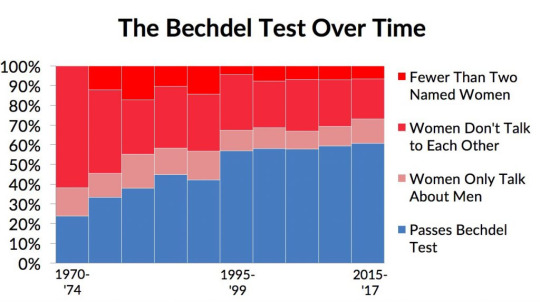
I must admit this is actually nice to see! It's soooorta plateauing but we all know why that is (*stares at camera*). This graph comes from Duke University, actually. And here's one of their studies on dialogue that they mention, put together in 2016.
And ooooooh would you look at this??: << “The entire Lord of the Rings trilogy, all Star Wars movies, The Social Network, Pulp Fiction and all but one of the Harry Potter movies fail this test,” said Ellen Tejle, the director of Bio Rio, an art-house cinema in Stockholm. >> On evaluating blockbusters on their female characters, in Sweden.
Anyway, problems with movies aside, problems with the Bechdel test itself aside, fanfiction has become a really wonderful place to fully pass the Bechdel Test and more. Not all fics do, but it's becoming something that people are increasingly aware of, much like the shift away from Mary Sue type characters in the mid-00's. It's rather fascinating!!
I hope this answers your question and more, my dear. <3
#bechdel test#2022frc#2022 fic reading challenge#ask#blissfullycamren02#fanfiction#movies#reading challenge
1 note
·
View note
Text
Check Please and the Bechdel Test
aka I’m still not sure if it passes and want opinions
(an overview of the bechdel test, if you’re wondering) (also, disclaimer: I have done what I consider to be fairly extensive research on the Bechdel test and do understand that it is not the be all and end all of measuring women’s representation in media, however, I still like to know if the media I’m watching/reading passes.)
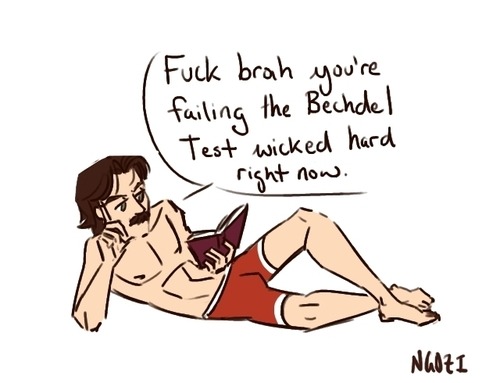
Although Check Please would earn an “F rating” for being written/illustrated/completely created by a woman, the female representation in comic doesn’t have quite the same ringing feminist endorsement. Despite having some really cool, diverse (and named) ladies, these ladies don’t talk to each other on screen very often. Considering the comic is about a men’s hockey team, it’s not surprising that Ngozi can’t afford too much screen time for characters that aren’t in the main cast. Ngozi does include women where she can (George, Prof Atley, Lardo) which I admire and she does include a myriad of other representation. It passes both the Vito Russo Test

and the Shukla Test
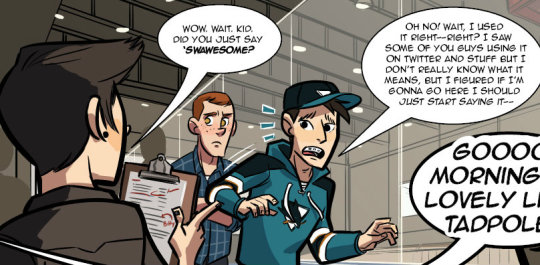
But I’m still trying to decide if it passes the Bechdel Test, the closest I’ve found are these:
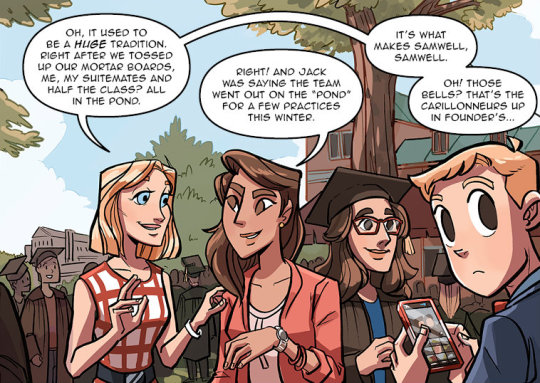
Alicia is so close but then Georgia mentions Jack. And then there’s this:

Now, this is the one that I’m unsure whether on not it passes because the trivia that they’re learning is about Kent Parson. So they’re not necessarily talking about a guy, just talking about trivia about a guy? I’m not sure if that makes this conversation fail? What do you think? Does Check Please pass?
EDIT: this conversation isn’t in context and is also implying they go hookup with rans and holster and so is an unfortunate 2/3, thanks to those who pointed it out though!
I will say that I have hope for Lardo and the new manager solidly passing the bechdel test in the next few updates!
#just something I've been thinking about lately#what do you guys think?#does it pass?#omgcheckplease#check please#omgcp#my content#sorta?#it doesn't pass the mako mori test#but it does pass the sexy lamp test#please be aware that I critique the things i love#this is not me saying I don't like the comic or respect n's work#you should have seen my review of the raven king#it was literally 2.5k#and i love the trc series#so this is LIGHT
63 notes
·
View notes
Text
Absolutely killing it at the box office ($438.5 million worldwide thus far), Wonder Woman introduces a new type of superhero – a woman who is both unflinching fierce and compassionate.
Diana, alongside her mother Queen Hippolyta (Connie Nielsen), learns of WWI from Steve.
Diana (Gal Gadot) is an Amazon who has always been attracted to combat and felt a strong sense of purpose and determination. She, however, has never had a chance to apply or devote herself to a cause as she has always lived on a peaceful and isolated island. When a mysterious man (Steve Trevor as played by Chris Pine) thus arrives on her island and informs her that a world war is occurring, Diana decides to aid humanity (despite all odds and doubts) and sets off on a journey to end the greatest of human wars.
The Bechdel, Russo, and Race Test
Wonder Woman passes the Bechdel test; it is shaky on whether or not the film passes the Russo test; and Wonder Woman does not pass the race test.
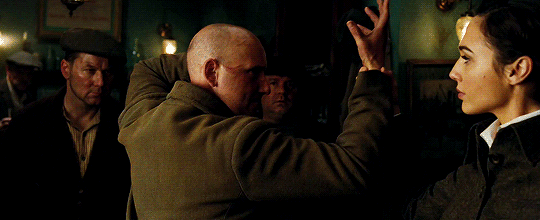
Diana tosses aside a man in a bar.
Wonder Woman supports a cast of both women and men. These two genders, however, rarely interact with one another as the film is divided into two parts – Themyscira, the exclusive home to Amazon women and Europe, a man’s land where women, apparently, are an endangered species as they rarely make an appearance. So how does this division of women and men impact Wonder Woman in relation to the Bechdel test? Well, women do talk to each other on several occasions and while only some of the women who talk to each other are named and men are mentioned at least 50% whenever women speak to each other, there are several instances where named women talk to each other without mentioning men so Wonder Woman passes the Bechdel test. Though it should be noted that most of the conversations that take place between the women of Wonder Woman occur because the first 30-40 minutes of the film is comprised of only women. After Diana leaves Themyscira, for example, there is only one other time that women have a conversation with one another and that’s when Diana first meets and befriends Etta Candy (Lucy Davis), Steve’s secretary. Diana and Dr. Maru/Dr. Poison (Elena Anaya), the only other woman of note in the second half of Wonder Woman and a baddie, don’t even speak to one another (in fact, they only encounter each other at the very end of the film and they merely lock eyes).
Antiope fights the Germans.
When it comes to other kinds of diverse representation in Wonder Woman, the film does not fare well. For example, there is only one hint that LGBTQIA characters even exist in Wonder Woman and this is when Antiope (Robin Wright), Diana’s aunt and mentor, is shot and killed by German soldiers and Menalippe (an Amazon) runs to Antiope’s side and cries out in anguish. It is suffice to say that this reference to a same sex relationship puts into question whether or not Wonder Woman passes the Russo test. After all, while Antiope is not solely defined by her sexual orientation (e.g., she is, first and foremost, defined as a warrior and as Diana’s mentor) and she is tied into the plot in such a way that her removal would have a significant effect (again, because she is Diana’s mentor and she shapes the woman that Diana becomes), the actual reference to Antiope’s sexuality is so loose and vague (not to mention that it occurs so quickly that if you blink you’ll miss it) that it is difficult to say that Wonder Woman fully satisfies “identifiably lesbian, gay, bisexual, intersex, queer, asexual and/or transgender” portion of the Russo test.
Wonder Woman does no better when it comes to the inclusion of people of color and meeting the standards of the race test. Case in point, there are only a few people of color in Wonder Woman (e.g., there are a couple of Black Amazons, Sameer [Saïd Taghmaoui] and The Chief [Eugene Brave Rock]); non-White individuals only speak a couple of lines throughout Wonder Woman; there is only one instance where people of color talk to each other (e.g., Sameer discusses breaking into a party and he thinks that he is talking to both Diana and The Chief, but unbeknownst to him, Diana had already left his presence before he had started talking); and Wonder Woman fails to pass the race test because the one time that non-White individuals talk to each other, they do so with the intention and belief that they are also speaking to a White woman (Diana) and they actually mention her while speaking to each other (e.g., once Sameer realizes that Diana wasn’t around while he was speaking, he questions Chief as to where she has gone).
*The Bechdel test entails three requirements:
1. It has to have at least two (named) women in it
2. Who talk to each other
3. About something besides a man
**The Vito Russo test entails three requirements:
1. The film contains a character that is identifiably lesbian, gay, bisexual, intersex, queer, asexual and/or transgender
2. The character must not be solely or predominately defined by her sexual orientation, gender identity and/or as being intersex
3.The character must be tied into the plot in such a way that her removal would have a significant effect
***The race or people of color (POC) test has three requirements:
1. It has two people of color in it
2. Who talk to each other
3. About something other than a White person
****Just because a film passes the Bechdel, Russo and race test does not mean that it is not sexist, heterosexist, racist and/or cissexist, etc. The Bechdel, Russo and race test is only a bare minimum qualifier for the representation of LGBTQIA individuals, women and people of color in film. The failure to pass these tests also does not identify whether the central character was a woman, a person of color or a LGBTQIA individual and it does not dictate the quality of the film.
The Bechdel, Russo, and Race Test: Wonder Woman Absolutely killing it at the box office ($438.5 million worldwide thus far), Wonder Woman introduces a new type of superhero – a woman who is both unflinching fierce and compassionate.
#Bechdel#Chris Pine#Connie Nielsen#Danny Huston#David Thewlis#DC#Elena Anaya#Ewen Bremner#film#Gal Gadot#Lucy Davis#Patty Jenkins#Race Test#Robin Wright#Saïd Taghmaoui#Vito Russo#Wonder Woman
0 notes
Text
Review: The Snow Gypsy
Review: The Snow Gypsy
By: Lindsay Jayne Ashford
Available on: Amazon, Audible, and Barnes and Noble.
Overview:
Blurb: Rose Daniels goes on a journey to try and track down her brother in post-World War II Spain. She falls in with a lovely band of travelling Gypsies who appreciate her abilities as a veterinarian and invite her to travel with them as they seek their summer campground. Each question Rose manages to…
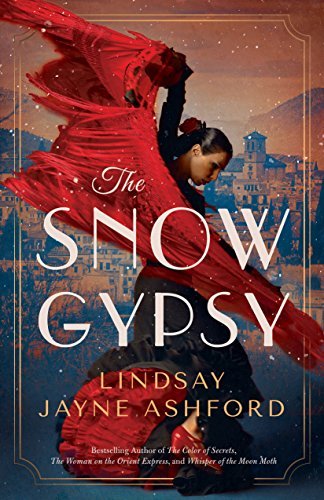
View On WordPress
#3.0 out of 5#Bechdel Test Pass#Bechdel-Wallace Pass#Cultural Heritage Fiction#Deggan Rule Test Pass#DuVernay Test Pass#Ellen Willis Test Pass#Gypsy#Historical Fiction#Historical World War II Fiction#Mako Mori Test Pass#Mary Sue Test Pass#Reading#Reading as a Coping Mechanism#Reading Challenge#Review#Sexy Lamp Test Pass#Tauriel Test Pass#Vito Russo Test Fail#World War II Historical Fiction
1 note
·
View note
Text
Review - Paranoid Park; or, Figuring Out Just How Much the Little Stuff Don't Matter (2007)
Text Aloud (6:15) version removed (for licensing reasons).
Audio version to be done (eventually).
This is essentially a repost from my Letterboxd review last year (before this blog’s creation). I just love this film so much that my review got out of hand lengthy to be point of being admittedly unreasonable for Letterboxd’s formatting.
WARNING: Having watched the film long before seeing the trailer, I highly recommend avoiding as much info about its plot as possible. That includes the premise, trailer, YouTube comments, and other reviews.
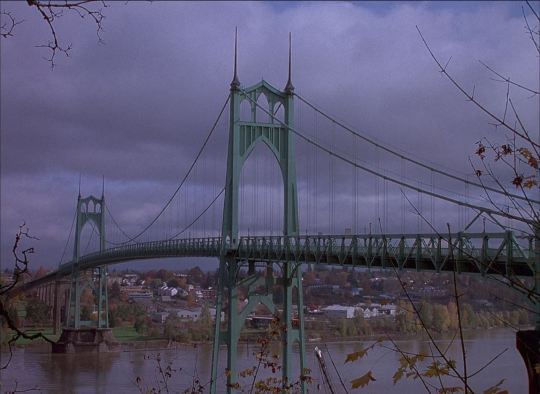
Slight Spoilers
(page break included just before Minor Spoilers)
First of all, let me tell you about dat opening. The film starts with a weird compilation of different songs set to a seemingly insignificant time-lapse of some river-over-passing bridge (I learned later that it's the St. Johns Bridge). Then the opening goes on for three more minutes surprisingly (and somehow beautifully). It's strange and a little unsettling. In hindsight, its probably a way to prepare the viewer for the strangeness of the film.
Now for the plot. This is a coming of age story about a kid who, after a traumatic experience, is dealing with the realization that shit don't matter. Girlfriends, divorce, teachers--all that shit. It's unfortunate that he had to be scarred for life only to effectively start growing up too quickly, but that's life for you. It just doesn't give a shit. And as the movie progresses we realize, to some degree, that neither does he.
While I found the back and forth time jumps to be confusing at first, I eventually got used to and learned to appreciate them as part of the cinematic experience. It's like you're on this confusing journey with Alex, but homeboy keepin' secrets from everybody so you're trying to figure out what happened and why he's doing the things he's doing.
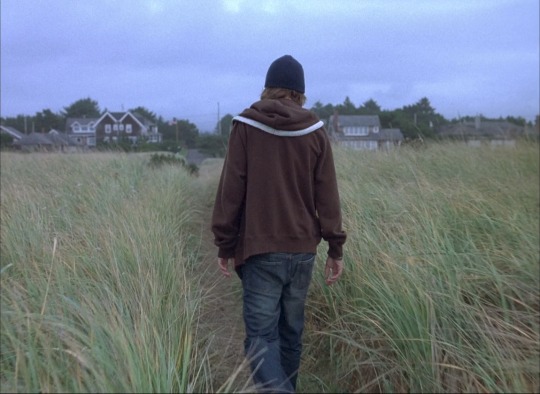
There are a number of scenes showing him just walking around as if part of his daily routine of sorts, but it seems more like an attempt to escape his concerns. This is quite the contrast to a scene that chronologically happens beforehand—the scene of him driving to the park. I found myself appreciating the intermission that this was. While it was odd at first, like the ladder climb in Metal Gear Solid 3, it doubled as a relaxing moment of subtle tension and an opportunity to really see him, especially as a regular kid.
Now about the cinematography. I like to take screenshots of films, and this one is full of screenshot-worthy scenes, especially during key conversations. Namely, the one between him and the officer. The cinematographer does everything right during that questioning scene. And dat ever encroaching camera? Damn, that's a nice shot. Don't even get me started on dat sound effect.
Speaking of sound, Paranoid Park does something unusual with its soundtrack to the point of being rather experimental, especially when certain sounds come into sudden focus as if painfully yanked straight from Alex's head in order to let us into a place he's keeping guarded from everyone else. With the way things are done, I was left throughout the film to wonder what was with the voice and sounds blended into the music. Honestly, I feel like there's more to the soundtrack and sound effects than I realize.
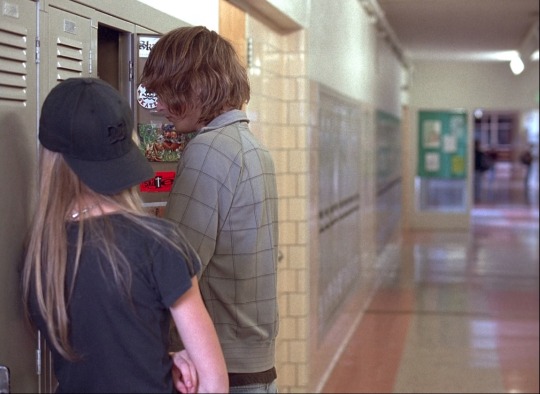
Similar to Wanuri Kahiu's Rafiki (2018), Paranoid Park has dialogue scenes without lip movement. I counted two in total. The second one was well enough hidden, but the first seemed unintentionally left noticeable. Either way, they both felt artful and experimental.
Speaking of dialogue, there are a few moments where characters say unnatural lines for their age. I found them very noticeable and a little distracting in terms of believability, but they don't ruin the scenes so it's forgivable.
If there's anything I must critique it's the fact that they're obviously teenagers until half-way through. That is to say most of their acting is rather raw and without projected character. Sometimes this works in such a way that the film seems more stylized. Other times, they're obviously teenagers. Except for Macy and Jennifer, though. They felt more natural, especially Jennifer.
Speaking of it working, I suddenly remember his little brother. That kid's voice was such that it seemed as if there was something wrong with his mic. He only had a couple of scenes, so I never got used to it.
Minor Spoilers
Let this minor spoiler digest for a moment: It took a traumatic experience for him to stop wasting time with someone he didn't like and start spending more with someone he did. That being said, I like the presentation of an obvious opportunity to pursue the prettier Rachel and repeat the same mistake.

Other Things I Loved:
The long takes.
The intimate focus on people's faces, especially when the editor slows it down.
The March of the Skater Kids.
The reflection shots.
When the hands [don't] touch.
When the last piece of the puzzle is found and everything makes sense.
That the best scene in the entire film is near the end when she's "pushing" him along the road.
Other Noteworthy Things:
There are entire scenes where Alex is effectively bearing the face of a liar. The way he delivers his lines during them is almost uncanny.
The fact that he wasn't even into it.
The conversations with Jennifer, especially the last one.
The fact that his parents are naturally clueless.
The line that tells the future.
The reason and revelation of why he's narrating.
The question I still have of whether or not he told the officer.
The fact that the actors who play Jared, Alex, Macy, and Jennifer are all 16, 15, 14, and 13 respectively.
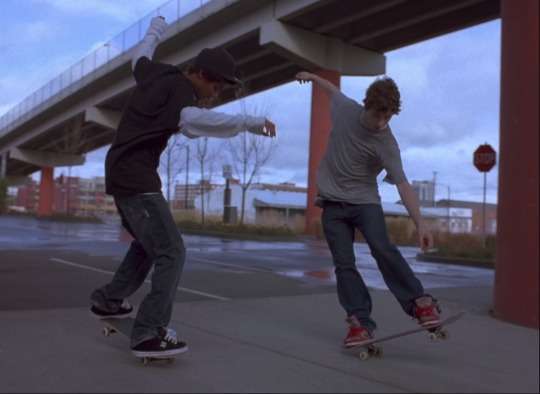
Fun Fact:
This film was shot with an aspect ratio of 1.33, which is "often referred to as ‘academy’, and more accurately 1.37:1." It's very noticeable, but not bothersome. In fact, the film looks wrong when cropped down to a more typical aspect ratio, which is what you'll find in it's many YouTube videos. There are just significant (and yet unappreciated) portions of the footage that become torn away from view when it isn't presented with the aspect ratio that the film was clearly designed to be presented in. Read Joe Beres' Walker article Paranoid Park’s aspect ratio conundrum to learn more and see an example of this for yourself.
Tests:
Because this is a repost, and I don’t feel like it, I’m gonna skip 3 crew tests completely. Here’s the test process for the rest, though.
#RePost#i love it#Paranoid Park#2007#dat soundtrack#MUBI#Blind Rating: 5/5#Watched: June 2019#friendship#childhood#skateboarding#Vito Russo Test FAILED#Mako Mori Test FAILED#Bechdel Test FAILED#DuVernay Test FAILED (F)#DuVernay Test FAILED#Waithe Test FAILED#Ko Test FAILED#Villalobos Test FAILED#Peirce Test FAILED#Villarreal Test PASSED#Landau Test PASSED#Hagen Test FAILED#Koeze-Dottle Test FAILED#Feldman Score UNSURE (3+/10)#Feldman Score UNSURE#Racial Bechdel Test FAILED#Native Bechdel Test FAILED#Native Female Bechdel Test FAILED#Riz Test FAILED
1 note
·
View note
Text
3 ways 'Deadpool' perfectly sums up Hollywood's LGBTQ problem.
Like many people, I fell head over heels in love with "Deadpool" last year.
The film, based on the Marvel comic, raked in over $700 million worldwide, making it the second-highest-grossing R-rated film ever made. Executives raced to get a sequel into production to feed America's unquenchable thirst for more Ryan Reynolds in a tight red suit (yes, please). "Deadpool 2" is slated for summer 2018.
A year and some odd months after "Deadpool's" release, GLAAD's Studio Responsibility Index (SRI) — the group's annual study on how lesbian, gay, bisexual, transgender, and other queer characters are depicted in film — landed in my inbox. "Deadpool" was one of the 125 films the study analyzed, and for my beloved superhero flick, the results weren't great.
Don't get me wrong; I still love the movie. But GLAAD's findings demonstrate just how problematic the superhero flick — and so many of our other Hollywood faves — really can be.
So buckle up, fellow "Deadpool" fans — this may not be easy to read.
GIF via "Deadpool."
1. For starters, Deadpool is pansexual. But you wouldn't know it from the movie.
In the Marvel universe, Deadpool was created as pansexual — meaning he's interested in all genders and orientations. When director Tim Miller confirmed before the movie's release that Deadpool's sexuality would stay true to its origins, many fans rejoiced — this would be the first big-budget superhero flick with an openly queer lead.
Then the film came out, and fans watched as Deadpool ... didn't.
GIF via "Deadpool."
In a press release, GLAAD pointed to "Deadpool" as an example of a film that "still [requires] the audience to have read press coverage or have outside knowledge" of a character's sexual orientation or gender identity because their queerness won't be identifiable in the film. (Honestly, I saw far more homoerotic behavior at frat parties in college than I did in "Deadpool.")
As a gay man, I want to support movies that show characters with stories like mine on screen, and it's frustrating when there's buzz surrounding an LBGTQ character in an upcoming film, only to have their on-screen queerness reduced to a suggestive sentence or ambiguous same-sex interaction (looking at you, new "Power Rangers" movie). Why can't openly queer characters actually be openly queer in their films?
2. "Deadpool" fails the Vito Russo Test — big time.
The Vito Russo Test — inspired by the feminist Bechdel Test and named after GLAAD co-founder Vito Russo — is a set of basic criteria to examine how LGBTQ characters and films are portrayed on screen.
To pass the test, the film must: 1. contain an LGBTQ character who is identifiably queer who is 2. intricately woven into the plot in a meaningful way and 3. not solely defined by their sexual orientation or gender identity.
"Deadpool" fails on the test's first, basic requirement: Reynolds' character, although technically pansexual, wasn't identifiably queer.
If you didn't know he was pansexual before seeing the film, would you have guessed he's not a straight, cisgender character? Probably not.
GIF via "Deadpool."
Sadly, "Deadpool" isn't the rare exception among LGBTQ films. Of the 23 movies in the study that featured queer characters in 2016, only nine of them passed the Vito Russo Test, according to GLAAD.
3. Deadpool is a big jokester. And while that's great for laughs, the jokes in the movie were not always great for the LGBTQ community.
And I say that as a gay man who thought "Deadpool" was hilarious.
As GLAAD wrote in its report:
"While director Tim Miller told press ahead of the film’s release that Deadpool was pansexual, the only references that made it to screen were played for comedic effect in throwaway jokes intended to emphasize just how outrageous the character is rather than any real sense of desire."
GIF via "Deadpool."
This isn't uncommon in films featuring LGBTQ characters, according to GLAAD's report. Often, queer characters and their identities are soley included as fodder for cheap jokes.
I truly hate being a buzzkill. But those throwaway jokes in "Deadpool" really do have an effect. As GLAAD continued:
"The portrayal of a pansexual identity as a brazen or scandalous trait, rather than a lived identity, has real consequences for bisexual+ people. Because their identities are often misunderstood, bisexual+ people are less likely to be out to family and friends than gay and lesbian people."
Pansexuality is an identity — not a punchline.
I write all of this not to rain all over "Deadpool's" parade, but in hopes that the sequel — and all of Hollywood, really — will do better next time.
Maybe "Deadpool 2" will include a queer main character of color; as the report noted, we need a whole lot more of those. Maybe that character will be a complex, fully realized woman, who doesn't fall into the tired tropes queer women often do on screen; as the report also noted, we desperately need more of those, too.
Or maybe — just maybe — Deadpool will find himself a man.
“I certainly wouldn’t be the guy standing in the way of that,” Reynolds responded in February 2016 to the prospect of Deadpool having a boyfriend. “That would be great.”
In more ways than one, yes it would, Ryan.
0 notes
Text
3 ways 'Deadpool' perfectly sums up Hollywood's LGBTQ problem.
[ad_1]
Like a lot of folks, I fell head over heels in enjoy with "Deadpool" previous calendar year.
The movie, based mostly on the Marvel comic, raked in over $700 million around the world, creating it the second-optimum-grossing R-rated movie at any time manufactured. Executives raced to get a sequel into creation to feed America's unquenchable thirst for far more Ryan Reynolds in a restricted red match (sure, be sure to). "Deadpool 2" is slated for summertime 2018.
A calendar year and some odd months following "Deadpool's" release, GLAAD's Studio Duty Index (SRI) — the group's once-a-year review on how lesbian, homosexual, bisexual, transgender, and other queer figures are depicted in movie — landed in my inbox. "Deadpool" was 1 of the one hundred twenty five movies the review analyzed, and for my beloved superhero flick, the outcomes were not fantastic.
Will not get me completely wrong I continue to enjoy the motion picture. But GLAAD's results show just how problematic the superhero flick — and so a lot of of our other Hollywood faves — definitely can be.
So buckle up, fellow "Deadpool" supporters — this may perhaps not be simple to go through.
GIF through "Deadpool."
one. For starters, Deadpool is pansexual. But you wouldn't know it from the motion picture.
In the Marvel universe, Deadpool was created as pansexual — that means he is fascinated in all genders and orientations. When director Tim Miller confirmed before the movie's release that Deadpool's sexuality would remain real to its origins, a lot of supporters rejoiced — this would be the to start with large-price range superhero flick with an overtly queer lead.
Then the movie came out, and supporters viewed as Deadpool ... did not.
GIF through "Deadpool."
In a push release, GLAAD pointed to "Deadpool" as an instance of a movie that "continue to [necessitates] the viewers to have go through push protection or have outside the house knowledge" of a character's sexual orientation or gender identification because their queerness will not be identifiable in the movie. (Truthfully, I observed considerably far more homoerotic habits at frat parties in college or university than I did in "Deadpool.")
As a homosexual guy, I want to assistance films that display figures with tales like mine on monitor, and it is really aggravating when there's excitement encompassing an LBGTQ character in an upcoming movie, only to have their on-monitor queerness diminished to a suggestive sentence or ambiguous very same-sex conversation (searching at you, new "Power Rangers" motion picture). Why are unable to overtly queer figures truly be overtly queer in their movies?
2. "Deadpool" fails the Vito Russo Test — big time.
The Vito Russo Test — encouraged by the feminist Bechdel Test and named following GLAAD co-founder Vito Russo — is a set of simple standards to examine how LGBTQ figures and movies are portrayed on monitor.
To pass the take a look at, the movie will have to: one. comprise an LGBTQ character who is identifiably queer who is 2. intricately woven into the plot in a significant way and three. not only defined by their sexual orientation or gender identification.
"Deadpool" fails on the test's to start with, simple prerequisite: Reynolds' character, whilst technically pansexual, was not identifiably queer.
If you did not know he was pansexual before looking at the movie, would you have guessed he is not a straight, cisgender character? Most likely not.
GIF through "Deadpool."
Regrettably, "Deadpool" just isn't the exceptional exception between LGBTQ movies. Of the 23 films in the review that highlighted queer figures in 2016, only nine of them passed the Vito Russo Test, according to GLAAD.
three. Deadpool is a large jokester. And when that is fantastic for laughs, the jokes in the motion picture were being not normally fantastic for the LGBTQ group.
And I say that as a homosexual guy who believed "Deadpool" was hilarious.
As GLAAD wrote in its report:
"When director Tim Miller told push ahead of the film’s release that Deadpool was pansexual, the only references that manufactured it to monitor were being played for comedic effect in throwaway jokes meant to emphasize just how outrageous the character is instead than any actual perception of need."
GIF through "Deadpool."
This just isn't unheard of in movies that includes LGBTQ figures, according to GLAAD's report. Normally, queer figures and their identities are soley integrated as fodder for low-priced jokes.
I definitely hate staying a buzzkill. But those people throwaway jokes in "Deadpool" definitely do have an effect. As GLAAD ongoing:
"The portrayal of a pansexual identification as a brazen or scandalous trait, instead than a lived identification, has actual effects for bisexual+ folks. For the reason that their identities are typically misunderstood, bisexual+ folks are much less possible to be out to family and good friends than homosexual and lesbian folks."
Pansexuality is an identification — not a punchline.
I compose all of this not to rain all over "Deadpool's" parade, but in hopes that the sequel — and all of Hollywood, definitely — will do superior future time.
Maybe "Deadpool 2" will include things like a queer most important character of color as the report famous, we will need a total large amount far more of those people. Maybe that character will be a intricate, completely realized lady, who does not slide into the fatigued tropes queer females typically do on monitor as the report also famous, we desperately will need far more of those people, far too.
Or it's possible — just it's possible — Deadpool will uncover himself a guy.
“I certainly would not be the male standing in the way of that,” Reynolds responded in February 2016 to the prospect of Deadpool having a boyfriend. “That would be fantastic.”
In far more strategies than 1, sure it would, Ryan.
[ad_2]
Supply hyperlink
from Viral News Around The World - Feed http://ift.tt/2rIlGqb
via IFTTT
0 notes
Text
3 ways 'Deadpool' perfectly sums up Hollywood's LGBTQ problem.
Like many people, I fell head over heels in love with "Deadpool" last year.
The film, based on the Marvel comic, raked in over $700 million worldwide, making it the second-highest-grossing R-rated film ever made. Executives raced to get a sequel into production to feed America's unquenchable thirst for more Ryan Reynolds in a tight red suit (yes, please). "Deadpool 2" is slated for summer 2018.
A year and some odd months after "Deadpool's" release, GLAAD's Studio Responsibility Index (SRI) — the group's annual study on how lesbian, gay, bisexual, transgender, and other queer characters are depicted in film — landed in my inbox. "Deadpool" was one of the 125 films the study analyzed, and for my beloved superhero flick, the results weren't great.
Don't get me wrong; I still love the movie. But GLAAD's findings demonstrate just how problematic the superhero flick — and so many of our other Hollywood faves — really can be.
So buckle up, fellow "Deadpool" fans — this may not be easy to read.
GIF via "Deadpool."
1. For starters, Deadpool is pansexual. But you wouldn't know it from the movie.
In the Marvel universe, Deadpool was created as pansexual — meaning he's interested in all genders and orientations. When director Tim Miller confirmed before the movie's release that Deadpool's sexuality would stay true to its origins, many fans rejoiced — this would be the first big-budget superhero flick with an openly queer lead.
Then the film came out, and fans watched as Deadpool ... didn't.
GIF via "Deadpool."
In a press release, GLAAD pointed to "Deadpool" as an example of a film that "still [requires] the audience to have read press coverage or have outside knowledge" of a character's sexual orientation or gender identity because their queerness won't be identifiable in the film. (Honestly, I saw far more homoerotic behavior at frat parties in college than I did in "Deadpool.")
As a gay man, I want to support movies that show characters with stories like mine on screen, and it's frustrating when there's buzz surrounding an LBGTQ character in an upcoming film, only to have their on-screen queerness reduced to a suggestive sentence or ambiguous same-sex interaction (looking at you, new "Power Rangers" movie). Why can't openly queer characters actually be openly queer in their films?
2. "Deadpool" fails the Vito Russo Test — big time.
The Vito Russo Test — inspired by the feminist Bechdel Test and named after GLAAD co-founder Vito Russo — is a set of basic criteria to examine how LGBTQ characters and films are portrayed on screen.
To pass the test, the film must: 1. contain an LGBTQ character who is identifiably queer who is 2. intricately woven into the plot in a meaningful way and 3. not solely defined by their sexual orientation or gender identity.
"Deadpool" fails on the test's first, basic requirement: Reynolds' character, although technically pansexual, wasn't identifiably queer.
If you didn't know he was pansexual before seeing the film, would you have guessed he's not a straight, cisgender character? Probably not.
GIF via "Deadpool."
Sadly, "Deadpool" isn't the rare exception among LGBTQ films. Of the 23 movies in the study that featured queer characters in 2016, only nine of them passed the Vito Russo Test, according to GLAAD.
3. Deadpool is a big jokester. And while that's great for laughs, the jokes in the movie were not always great for the LGBTQ community.
And I say that as a gay man who thought "Deadpool" was hilarious.
As GLAAD wrote in its report:
"While director Tim Miller told press ahead of the film’s release that Deadpool was pansexual, the only references that made it to screen were played for comedic effect in throwaway jokes intended to emphasize just how outrageous the character is rather than any real sense of desire."
GIF via "Deadpool."
This isn't uncommon in films featuring LGBTQ characters, according to GLAAD's report. Often, queer characters and their identities are soley included as fodder for cheap jokes.
I truly hate being a buzzkill. But those throwaway jokes in "Deadpool" really do have an effect. As GLAAD continued:
"The portrayal of a pansexual identity as a brazen or scandalous trait, rather than a lived identity, has real consequences for bisexual+ people. Because their identities are often misunderstood, bisexual+ people are less likely to be out to family and friends than gay and lesbian people."
Pansexuality is an identity — not a punchline.
I write all of this not to rain all over "Deadpool's" parade, but in hopes that the sequel — and all of Hollywood, really — will do better next time.
Maybe "Deadpool 2" will include a queer main character of color; as the report noted, we need a whole lot more of those. Maybe that character will be a complex, fully realized woman, who doesn't fall into the tired tropes queer women often do on screen; as the report also noted, we desperately need more of those, too.
Or maybe — just maybe — Deadpool will find himself a man.
“I certainly wouldn’t be the guy standing in the way of that,” Reynolds responded in February 2016 to the prospect of Deadpool having a boyfriend. “That would be great.”
In more ways than one, yes it would, Ryan.
from Upworthy http://ift.tt/2qkVYs4
via cheap web hosting
0 notes
Text
GLAAD finds historic low percentage of Hollywood Films pass Vito Russo Test in fourth annual Studio Responsibility Index
GLAAD is the Gay & Lesbian Alliance Against Defamation, a civil liberties union working to ensure the fair and equal representation of the lesbian, gay, bisexual, and transgender community in films. Each year, GLAAD analyzes films released in Hollywood from the seven largest film studios. This studio responsibility index reports on GLAAD’s observations of how LGBT representation in film has progressed from the elimination of the Motion Picture Production Code which was the censorship of LGBT individuals and characters in films made by major movie production companies from the years 1930 to 1968. The Motion Picture Production Code did not explicitly state that gay and lesbian scenes were to be prohibited, but rather it was implied to be known that it was forbidden. Since the ban there has been more and more LGBT representation in media, but there is still a noted difference between the quantity of heterosexual subjects and LGBT subjects in many films. To test this GLAAD uses the Vito Russo Test named after GLAAD’s founder and film historian. This test is used to analyze how LGBT characters are represented in a fictional film.
The Vito Russo Test uses criteria:
· The film contains a character that is identifiably lesbian, gay, bisexual, and/or transgender
· That character must not be solely or predominantly defined by their sexual orientation or gender identity, meaning that the character has unique character traits commonly used to differentiate straight characters from one another.
· The LGBT character must be tied into the plot in such a way that their removal would have a significant effect. Meaning they are not there to simply provide colorful commentary, paint urban authenticity, or (perhaps most commonly) set up a punchline. The character should matter.
This criterion is to ensure and promote a more truthful and positive representation of LGBT characters in film. In 2015 GLAAD analyzed 126 releases from major studios and found that only 17.5% included characters that were LGBT. Within that statistic a majority were minor characters, with a very low amount of them being Transgender. Minor characters often had 10 minutes or less of screen time. The movies that these studios released in 2015 received a rating of either Good, Adequate, or Failing. None of the studios got a rating of good, four received a rating of adequate, and three received a failing rating.
Adequate is no longer adequate according to GLAAD. LGBT characters of color in the past year have decreased in rate with a near 7% drop. While there were no recognizable transgender characters in films released in 2014, in 2015 only one transgender woman appear in a film as a minor role purely as a punchline for the audience to laugh at when her gender identity is revealed. Only 8 of the 22 major studio films passed the Vito Russo test in 2015. According to GLAAD this is the lowest percentage in the study’s history.Even with the elimination of censorship of LGBT characters in film after the Motion Picture Production Code in 1968 there is still a concerning lack of representation. If there are LGBT characters that pass the Vito Russo test they still may not be realistically portrayed. Inaccurate portrayal of any marginalized community can cause backlash and offense to these movies released. While there are moral implications to misrepresentation, this can also be costly to these movie and distribution companies reputation. Representation in films has a big impact on how we as a society perceive groups such as the LGBT community. Understanding the history of LGBT film as a whole and the past representations of the community can help with future movies that choose to include an LGBT character.
0 notes